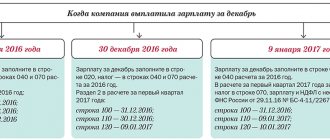Every working Russian citizen pays 13% of his salary monthly as income tax. The child tax deduction allows you to reduce the amount from which tax will be withheld, and accordingly reduce the personal income tax itself. So, from the first month of a child’s life in a family, parents, adoptive parents, guardians or trustees will receive a little more money in their hands.
Automatic calculation of income tax, maintaining personnel records, calculating salaries, deductions is convenient in the accounting web service “Kontur.Accounting”.
Get free access for 14 days
Who can take the standard deduction for children?
Standard deductions for children are prescribed in the Tax Code of the Russian Federation in Art. 218. The standard child deduction can be received by all employees who support children. The following categories of employees can receive a deduction:
- natural and adoptive parents;
- spouses of such parents;
- adoptive parents, guardians and trustees.
The deduction applies to children under 18 years of age. If the child is older, but is a graduate student, resident, intern, student or full-time student, the employee can receive a deduction until the child turns 24 years old.
An employee can receive a deduction monthly until his taxable income reaches the maximum level. In 2021, the amount of income within which deductions are provided for children will remain the same as in 2021 - 350 thousand rubles . The deduction does not need to be provided from the month in which the employee’s income exceeded the specified amount.
The amount of income must include only income from which personal income tax is withheld at a rate of 13%. Only dividends are not taken into account. And if the income is partially taxed, count only the taxable amount in your income. For example, tax is not withheld from the amount of financial aid up to 4,000 rubles, but over 4,000 is withheld. You need to calculate the amount of financial assistance in excess of 4,000 rubles.
Types and amounts of standard deductions for children
For now, the amounts of deductions will also remain at the same level and will be provided in each month of the year until the month in which income exceeds 350 thousand rubles, in the following amounts:
- 1,400 rubles - for the first and second child;
- 3,000 rubles - for the third and each subsequent child;
- 12,000 rubles (for a parent, spouse of a parent and adoptive parents) - for each disabled child under 18 years of age and full-time students, graduate students, residents, interns and students under 24 years of age, if they are disabled people of group I or II;
- 6,000 (for a guardian, trustee, foster parent, spouse of a foster parent) - for each disabled child under 18 years of age and each full-time student, graduate student, resident, intern, cadet under 24 years of age, if they are disabled I or Group II.
The standard deduction for disabled children is added to the general deduction. For example, the only child of a disabled person is entitled to a deduction of 13,400 rubles - 12,000 for a disabled child and 1,400 rubles for the first child. If the disabled child is the third in a row, the total deduction will be 15,000 rubles.
Deputies developed a bill in which they planned to increase the amount of deductions. But at this stage it has not yet been agreed upon; it was rejected several times, and as a result, the consideration was postponed. The plans were to increase deductions to:
- 2,500 rubles - for the first and second child;
- 4,500 rubles - for the third and each subsequent child;
- 12,500 rubles (for a parent, spouse, parent and adoptive parent) - for each disabled child under 18 years of age and full-time students, graduate students, residents, interns and students under 24 years of age, if they are disabled people of group I or II;
- 8,000 (for a guardian, trustee, foster parent, spouse of a foster parent) - for each disabled child under 18 years of age and each full-time student, graduate student, resident, intern, cadet under 24 years of age, if they are disabled I or Group II.
Standard tax deductions
Personal income tax (NDFL) is paid by the taxpayer on all types of income received from a variety of sources - from the sale of property to winning the lottery. At the same time, the law not only establishes this obligation, but also provides taxpayers with certain rights, in particular, the right to receive tax deductions.
A tax deduction is an amount that reduces the amount of income (the so-called tax base) on which tax is paid.
In some cases, a tax deduction means the return of part of previously paid income tax for an individual, for example, in connection with the purchase of an apartment, expenses for treatment, education, etc.
Important
It is not the entire amount of expenses incurred within the declared deduction that is subject to refund, but the corresponding amount of previously paid tax.
The Tax Code provides for six groups of tax deductions:
- standard tax deductions (Article 218 of the Tax Code of the Russian Federation);
- social tax deductions (Article 219 of the Tax Code of the Russian Federation);
- property tax deductions (Article 220 of the Tax Code of the Russian Federation);
- professional tax deductions (Article 221 of the Tax Code of the Russian Federation);
- tax deductions when carrying forward losses from transactions with securities and transactions with financial instruments of futures transactions traded on the organized market (Article 20.1 of the Tax Code of the Russian Federation);
- tax deductions when carrying forward losses from participation in an investment partnership to future periods (Article 220.2 of the Tax Code of the Russian Federation).
A citizen who:
- is a tax resident of the Russian Federation;
- At the same time, he receives income from which personal income tax is withheld at a rate of 13%.
How to determine the amount of tax deduction for training expenses
In 2012, Ivanov I.I. received income taxed at a rate of 13% in the form of wages in the amount of 50,000 rubles.
In the same year Ivanov I.I. paid 10,000 rubles for my training. and decided to get a tax deduction for expenses related to his studies.
Considering that such a deduction is provided in the amount of expenses actually incurred, but not more than the established amount, in the tax return he has the right to indicate the entire amount of his educational expenses - 10,000 rubles. However, not the entire amount will be returned to him, but the corresponding amount of tax paid, that is, 10,000 rubles. x 13% = 1300 rub.
Tax deductions cannot be applied by individuals who are exempt from paying personal income tax due to the fact that they, in principle, have no taxable income. These include:
- unemployed people who have no other source of income other than state unemployment benefits;
- individual entrepreneurs who apply special tax regimes and do not have other income taxed at a rate of 13%.
As a general rule, tax deductions for personal income tax are provided at the end of the tax period (calendar year) by the tax office at the place of residence of an individual upon filing a tax return for personal income tax (form 3-NDFL) with the necessary set of documents attached to it.
At the same time, some types of deductions can be provided by a tax agent, usually an employer, when contacted before the end of the year.
Tax agents for personal income tax are Russian organizations, separate divisions of foreign organizations in the Russian Federation, as well as individual entrepreneurs, notaries engaged in private practice, lawyers who have established law offices, from which or as a result of relations with which the taxpayer received income subject to personal income tax (clause 1 Article 226 of the Tax Code).
Standard tax deductions
Standard tax deductions are provided to certain categories of individuals, each of which has its own fixed deduction amount. Standard tax deductions can be applied by taxpayers specified in paragraphs. 1, 2 and 4 clause 1 art. 218 Tax Code.
There are two types of standard tax deductions:
- deduction for the taxpayer;
- deduction for child(ren).
Standard taxpayer deduction
This type of standard tax deduction is provided to two categories of individuals:
- "Chernobyl victims"; disabled people of the Great Patriotic War; disabled military personnel who became disabled in groups II and III due to wounds, contusions or injuries received during the defense of the USSR, the Russian Federation, and others - in the amount of 3,000 rubles per month;
- Heroes of the Soviet Union and Heroes of the Russian Federation; disabled people since childhood, disabled people of groups I and II; parents and spouses of military personnel who died defending the USSR and the Russian Federation; citizens who took part, by decision of government authorities, in hostilities on the territory of the Russian Federation, and others - in the amount of 500 rubles per month.
A complete list of individuals who may qualify for a standard taxpayer deduction is indicated in paragraphs. 1 and 2 paragraphs 1 art. 218 Tax Code.
Important
If an individual is entitled to two standard deductions per taxpayer, then he is granted the maximum of them, i.e. they cannot be summed up and used simultaneously.
Standard child tax credit
The standard child(ren) deduction is available to taxpayers who support a child(ren).
These include taxpayers specified in paragraphs. 4 paragraphs 1 art. 218 of the Tax Code, namely:
- parents, including adoptive ones;
- spouses of parents (including adoptive ones);
- adoptive parents;
- guardians or trustees.
A deduction for a child (children) is provided until the month in which the taxpayer’s income, taxed at a rate of 13% and calculated on an accrual basis from the beginning of the year, exceeded 280,000 rubles. The deduction is canceled from the month when the employee’s income exceeds this amount.
- Tax deduction from 01/01/2012 for the first and second child 1400 rubles
- Tax deduction for the third and each subsequent child is 3,000 rubles
- for every disabled child under 18 years of age; or a full-time student, graduate student, resident, intern, student under the age of 24, if he is a disabled person of group I or II 3000 rubles
The threshold for applying a tax deduction is RUB 280,000.
To correctly determine the amount of the deduction, it is necessary to line up the children according to their dates of birth.
The first born child is the oldest child, regardless of whether a deduction is provided for him or not.
Important
If spouses, in addition to a common child, have a child from an early marriage, for each of whom they pay alimony, the common child is considered the third.
How to determine the amount of deduction taking into account the order of children
Matveeva E.V. four children aged 16,15, 8 and 5 years.
Moreover, her monthly income (salary) is 40,000 rubles.
Matveeva E.V. submitted a written application to the employer to receive a standard tax deduction for all children: for the maintenance of the first and second child - 1,400 rubles each, the third and fourth - 3,000 rubles. per month.
Thus, the total amount of tax deduction was 8,800 rubles. per month.
This amount will be deducted from the income of Matveeva E.V. until July inclusive, since it is in this month that taxable income from the beginning of the year will reach the threshold of 280,000 rubles.
Every month from January to July the employer will pay his employee Matveeva E.V. Personal income tax from the amount of 31,200 rubles, received from the difference of income taxed at a rate of 13% in the amount of 40,000 rubles and the amount of tax deduction in the amount of 8,800 rubles:
Personal income tax = (40,000 rubles - 8,800 rubles) x 13% = 4,056 rubles.
Thus, in the hands of Matveev E.V. will receive 35,994 rubles.
If Matveeva E.V. did not apply for a deduction and did not receive it, then the employer would calculate personal income tax as follows:
Personal income tax = 40,000 rubles. x 13% = 5,200 rubles, income minus personal income tax would be 34,800 rubles.
A standard tax deduction for a child (children) can be provided by a tax agent (employer) when contacted before the end of the year. To do this, the employee must:
Step #1
Write an application for a standard tax deduction for a child (children) addressed to the employer.
Step #2
Prepare copies of documents confirming the right to receive a deduction for the child (children):
- birth or adoption certificate of a child;
- certificate of disability of the child (if the child is disabled);
- a certificate from the educational institution stating that the child is a full-time student (if the child is a student);
- document confirming the registration of marriage between parents (passport or marriage registration certificate).
Step #3
If the employee is the only parent^ (the only adoptive parent), it is necessary to supplement the set of documents with a copy of the document certifying that the parent is the only one.
Such documents include:
- death certificate of the second parent;
- an extract from the court decision recognizing the second parent as missing;
- a certificate of birth of a child, drawn up from the words of the mother at her request (according to form No. 25, approved by Decree of the Government of the Russian Federation of October 31, 1998 No. 1274);
- a document certifying that the parent is not married (passport).
Important
In some cases, for example, for a single parent, the deduction amount may be doubled. At the same time, the parents being divorced and failure to pay child support does not imply the absence of a second parent for the child and is not a basis for receiving a double tax deduction.
Step #4
If the employee is a guardian or trustee, it is necessary to supplement the set of documents with a copy of the document on guardianship or trusteeship of the child. Such documents include:
- a resolution of the guardianship and trusteeship body or an extract from the decision (resolution) of the said body on the establishment of guardianship (trusteeship) over the child;
- agreement on the implementation of guardianship or trusteeship;
- agreement on guardianship of a minor citizen;
- foster family agreement.
When submitting copies of documents confirming the right to deduction to the tax authority, it is recommended to have their originals with you for verification by a tax inspector.
Step #5
Contact the employer with an application for a standard tax deduction for the child (children) and copies of documents confirming the right to such a deduction.
Important
If a taxpayer works for several employers at the same time, the deduction at his choice can be provided only with one employer.
If during the year standard deductions were not provided by the employer or were provided in a smaller amount, the taxpayer has the right to receive them when filing a personal income tax return with the tax authority at his place of residence at the end of the year.
In this case, the taxpayer must:
- Fill out a tax return (form 3-NDFL) at the end of the year.
- Obtain a certificate from the accounting department at your place of work about the amounts of accrued and withheld taxes for the corresponding year in form 2-NDFL.
- Prepare copies of documents confirming the right to receive a deduction for the child (children).
- Provide the tax authority at your place of residence with a completed tax return with copies of documents confirming your right to receive a standard tax deduction.
The tax return and accompanying documents confirming the correctness of the calculations and the validity of the requested deduction are checked within 3 months from the date of their submission to the tax authority (Clause 2 of Article 88 of the Tax Code).
If the submitted tax return has calculated the amount of tax to be refunded from the budget, together with the tax return you can submit an application for a personal income tax refund in connection with the provision of a standard tax deduction.
The amount of overpaid tax is subject to refund upon application of the taxpayer within one month from the date the tax authority receives such an application, but not earlier than the end of the desk tax audit (Clause 6 of Article 78 of the Tax Code).








